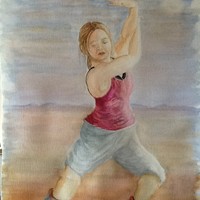 Hannah Sampson dreamed of being a full-time dancer from when she first started ballet classes aged five. Now 22, she’s made it. But it hasn’t always been that easy she told Simon Jarrett
Hannah Sampson dreamed of being a full-time dancer from when she first started ballet classes aged five. Now 22, she’s made it. But it hasn’t always been that easy she told Simon Jarrett
It sounds like a pretty straightforward and untroubled career progression. Ballet classes from age five, a GCSE in dance at school, a diploma in dance and musical theatre from Kingston College, a part-time job with a dance company, and finally full-time work teaching dance and performing.
Life now involves working with internationally renowned choreographers such as Charlotte Vincent of the Vincent Dance Theatre, as well as national and international performance tours. Except there’s a lot more to the story than that.
Hannah’s progress to where she is today is one in which she has always had to fight against being characterised as a dancer with Down’s syndrome, rather than a dancer in her own right. This has involved an awful lot of determination and single-mindedness from her, and a track-record of making the right call at the right time when faced with critical career decisions. She studied ballet to grade 2 but realised early on that in a world where only a tiny minority make it, the chances for a dancer with Down’s syndrome were virtually non-existent.
Despite her love of ballet, she switched to contemporary dance. She attended mainstream school, rather than special school and it was this that gave her the GCSE in dance that took her to college and a dance diploma. And when the chance of work-experience came up at Surrey-based Stopgap Dance Company she took it, prepared to work her way up from the bottom. This led to the part-time work, then the full-time job, and the hard-won status of both teacher and performer.
Meeting Hannah at a Birmingham conference to promote participation by people with learning disabilities in the arts, that single-mindedness is clear to see. It has always been her love of dance that has driven her and it is clear that she is on a mission to get the whole population dancing.
“If you think you can’t dance, try it out”, is her advice to anyone sitting nervously on the side lines. Dance can be fun and a hobby as well as a profession. In her own case she has always been keen not to judge herself as a disabled person but as an artist. It is interesting that her starting point is her own judgement of herself, rather than other people’s. It is perhaps this self-belief that has challenged the perceptions of others and brought her to the point she has reached today.
It was always her dream to be a successful, mainstream dancer and she talks about her right to pursue her dream. Beneath the bubbly, warm generous personality lies an iron will that seems to propel her through whatever prejudices or setbacks she faces.
When she first taught a class of non-disabled dancers, she saw straightaway that it was difficult, in her words, “to get them on the same page”. She did it by simply engaging with them as a dance teacher, sharing her love of dance and her skills, until they saw the value of what she was giving them. She comments casually, “It’s something they learn”.
Her next ambition is to choreograph for both disabled and non-disabled dancers. She is in the right place for this. Stopgap Dance, who bring together exceptionally talented disabled and non-disabled dancers, have an excellent track record in producing stunning dance choreography. The learning disabled, internationally-performed choreographer Chris Pavia has also emerged from the Stopgap talent stable.
To watch Hannah Sampson dance in his Awakening is to see a fusion of dance and choreographic talent that resists any attempt to place a limit on people’s talents or abilities.
Hannah Sampson, renowned dance performer, teacher – where will she go next? Keep watching.
Stopgap dance company http://stopgapdance.com/
You can see clips from Chris Pavia’s Awakening, with Hannah Sampson dancing, on YouTube: https://www.youtube.com/watch?v=M9Y5gxZi6so
